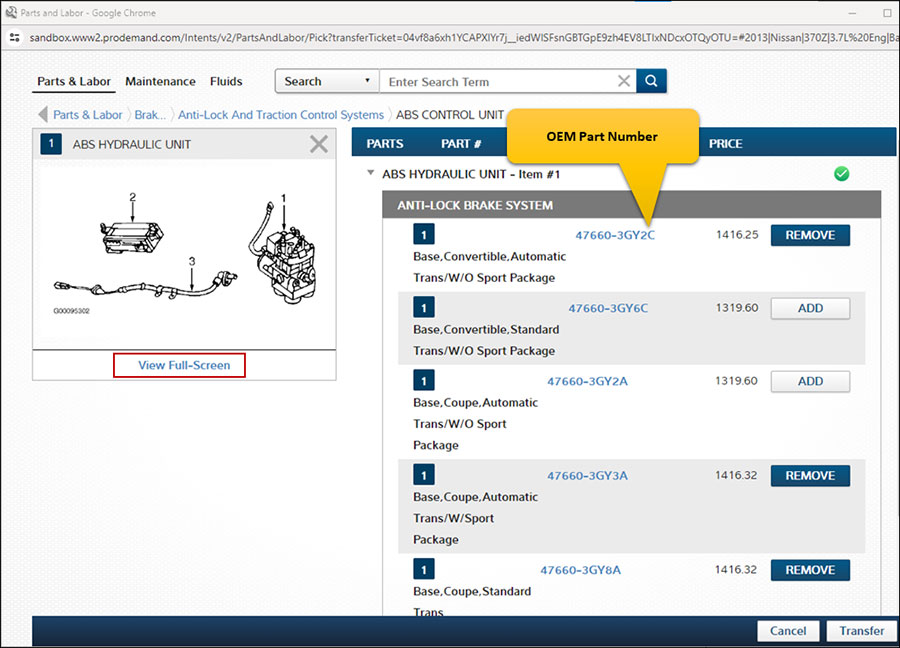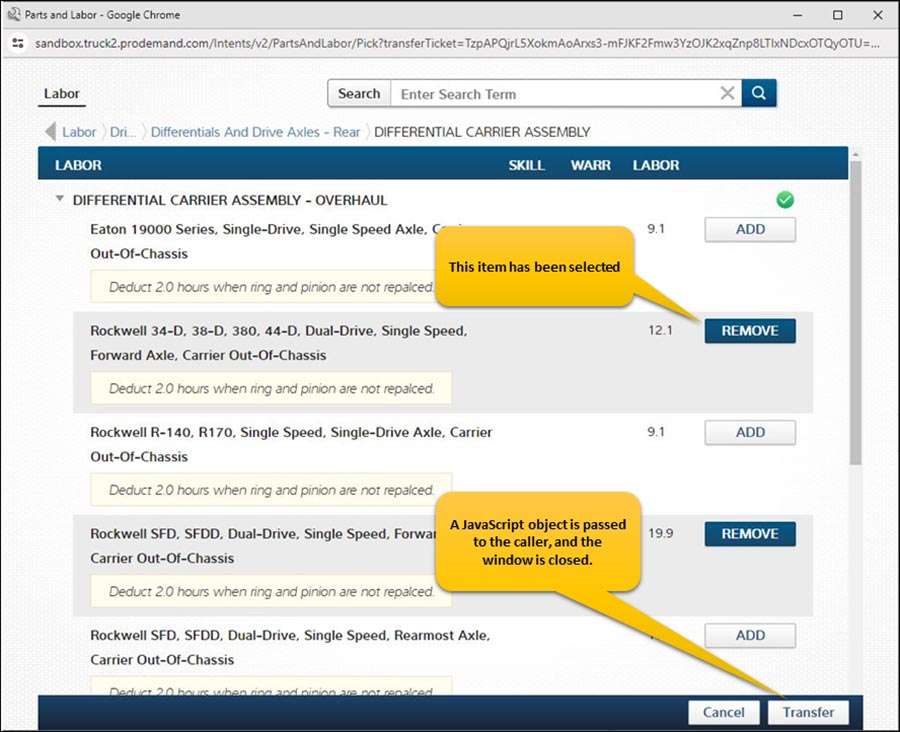Mitchell 1 provides TPMS information to Modern Tire Dealer, an award-winning publication that writes editorial content geared to independent tire dealers. We’re sharing this content in our blog, with a link to the Modern Tire Dealer website where you can read the article in full. The TPMS information in this article may also be accessed in either the TPMS or the reset procedures quick link in our ProDemand® auto repair information software, along with other important reset procedure data for the selected vehicle.
The tire pressure monitoring system (TPMS) of the 2010-2018 Ford Econoline (E150-E450) monitors the air pressure in the 4 road tires with wheel-mounted tire pressure sensors. The sensors transmit radio frequency signals to the smart junction box (SJB) approximately every 60 seconds when the vehicle speed exceeds 20 mph (32 km/h). If the vehicle is stationary for more than 30 minutes, the sensor will enter into a “sleep mode” and stop transmitting.
Each tire pressure sensor transmission is compared against a low-pressure limit (the pressure listed on the vehicle certification label minus 25%, which will be about 6-9 psi). If it is determined that the tire pressure has fallen below this limit, the SJB sends a message to the instrument cluster, which then illuminates the low pressure warning indicator and displays the appropriate message(s) in the message center (if equipped).
This vehicle may be equipped with one of two different kinds of sensors: a strap and cradle sensor or a valve-mounted sensor. In either case, the sensor cannot be seen unless the tire is removed. The valve stem’s appearance can be used to determine the type of sensor that is used in the wheel. The following 2 types of valve stems are used on wheels that are equipped with strap and cradle mounted sensors.
1) The valve has a rubber seal between the valve and the wheel with brass of a uniform diameter all the way down to the seal.
2) The valve is all metal and is attached to the wheel by a nut. Valve stems that are equipped with valve-mounted sensors have a rubber seal against the wheel, and an extra brass shoulder, larger in diameter and with no threads, that can only be seen when the valve cap is removed.
All tire pressure sensors are battery-operated. The strap and cradle sensors are mounted to metal brackets (called cradles) on the wheels inside the tires. The sensors are mounted 180 degrees from valve stem. The tire pressure sensor may be serviced separately, but the cradle and strap must be replaced together. The valve-mounted sensors are attached to the portion of the valve stem located inside the wheel with a T10 Torx screw. Under the following conditions, the TPMS may not function properly:
- Low tire pressure.
- Tire pressure sensor is missing or damaged.
- Spare tire is installed as a road wheel.
- Incorrect tire pressure sensor is installed.
- The tire pressure sensor is installed incorrectly.
- Non-OEM wheels are installed (aftermarket rims).
- Non-OEM equipped run-flat tires are installed.
- Other non-OEM modifications (roll cages, service barriers, part racks, ladder racks, etc.).
Tire pressure monitor warning indicators
NOTE: As ambient temperature decreases by 6 degrees Celsius (10 degrees Fahrenheit), tire pressure decreases 1 psi (7 kPa). Because tire pressures fluctuate with temperature changes, tire pressures must be set when tires are at outdoor ambient temperatures. Tire pressure may drop enough to be detected by the TPMS, which will activate the low pressure warning light.
When the tire pressure warning light comes on solid and message center displays “LOW TIRE PRESSURE,” check the air pressure of all tires and adjust to the specified cold pressure listed on the vehicle certification label (found on the driver’s door or door pillar).
Drive the vehicle at 20 mph (32 km/h) for at least 2 minutes. If the vehicle has been stationary for more than 30 minutes, the sensor will enter into a “sleep mode” and stop transmitting. Make sure the warning light goes off. If the warning light stays on, there is a malfunction in the TPMS. See the appropriate manufacturer service information. When the tire pressure warning light flashes for 70 seconds and then remains illuminated, after bulb-check has been performed and the message center displays warning messages, there is a malfunction in the TPMS. See the appropriate manufacturer service information.
TPMS reset procedures
NOTE: If the tire pressure sensor is replaced, it will need to be trained. If the vehicle has different front and rear tire pressures, the tire pressure has to be adjusted and the TPMS sensors has to be trained. If the vehicle has the same tire pressure on the front and rear tires, the TPMS is not affected by wheel and tire rotation.
When the tire pressure warning light comes on solid and the message center displays “LOW TIRE PRESSURE,” check the air pressure of all tires and adjust to the specified cold pressure listed on the vehicle certification label (found on the driver’s door or door pillar). Drive the vehicle at 20 mph (32 km/h) for at least 2 minutes. Ensure that the TPMS indicators go out. The TPMS sensor activation procedure may also be used to trigger a pressure sensor broadcast. See “Tire pressure sensor activation.” Ensure that the TPMS indicators go out.
Tire pressure sensor activation
1) Turn the ignition switch to the ON position.
2) Place the activation tool on the left front tire sidewall at the valve stem.
NOTE: A green light will flash and a beep will sound on the activation tool for each successful TPMS sensor response.
3) Press the test button on the activation tool to activate the TPMS sensor. For best results, activate each sensor twice.
NOTE: If, after adjusting tire pressures and activating sensors, the tire pressure warning light is still illuminated, there is a malfunction in the TPMS system. See the appropriate manufacturer service information.
4) Perform the activation procedure for each remaining tire.
Demounting/mounting procedures
CAUTION: The tire should be demounted from the wheel using the tire changer manufacturer’s instructions. Use the following information to avoid damage during the demounting/mounting procedures.
CAUTION: The tire and wheel must always be correctly matched. It is very important to determine the size of each component before any assembly operations commence. Failure to adhere to these instructions can result in an explosive separation and cause serious bodily injury or death.
CAUTION: Use only wheels and wheel nuts that have been designed for the current model year. Tire pressure sensors are not designed to be used with aftermarket wheels. Aftermarket wheels or wheel nuts may not fit or function correctly, and can cause personal injury or damage to the vehicle. A wheel and tire assembly equipped with tire pressure sensor will have the following verbiage stamped or cast on the wheel: “Sensor May Be Inside.”
CAUTION: Tighten wheel nuts in a star pattern. Failure to follow tightening specifications may result in high brake disc runout, serious injury or death.
NOTE: The use of run-flat tires (tires with steel body cord plies in the tire sidewall) when the vehicle is not originally equipped is not recommended, as it may cause the TPMS to malfunction.
NOTE: If possible, use a digital tire gauge (Ford Part #204-354, for example) any time tire pressures are measured to be sure that accurate values are obtained. Ford recommends the use of a digital or dial type tire pressure gauge rather than a stick type gauge for increased accuracy.
Read more:






